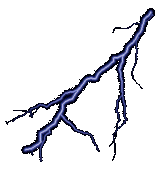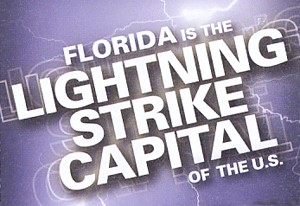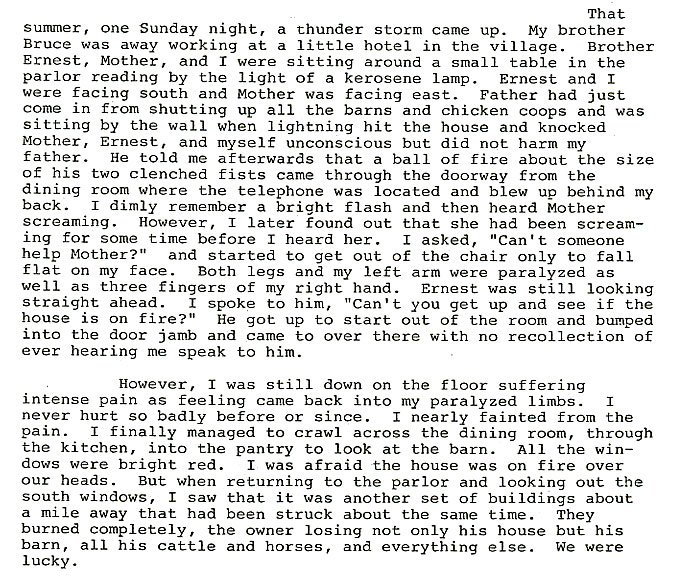|
|
|
Welcome to Roger Russell's |
These pages are copyrighted.
No portion of this site may be reproduced in whole or in part
without written permission of the author.
A Natural Resource
Central Florida has many great tourist attractions. We have Disney, Universal Studios, Sea World, Cape Canaveral, Cypress Gardens, Silver Springs, Gatorland, Daytona, etc. We also have many beaches with warm water as well as warm winters, no snow and lots of sunshine. A natural resource that is not advertised is the numerous thunderstorms that occur, mainly during the summer months.
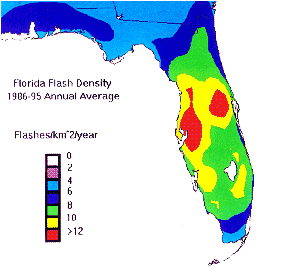
 The storms are a natural occurrence as the
heated air rises and brings in moist air from both east and west coasts of the
Florida peninsula. During the summer, high altitude shear winds are not present
and by afternoon, the clouds continue to build into the familiar anvil shape of
cumulonimbus clouds, and away we go! The storms occur almost every afternoon
but are scattered so we don't always get one right over our house every day.
Some big storms generate up to 40,000 lightning strikes.
The storms are a natural occurrence as the
heated air rises and brings in moist air from both east and west coasts of the
Florida peninsula. During the summer, high altitude shear winds are not present
and by afternoon, the clouds continue to build into the familiar anvil shape of
cumulonimbus clouds, and away we go! The storms occur almost every afternoon
but are scattered so we don't always get one right over our house every day.
Some big storms generate up to 40,000 lightning strikes.
The map shows the history of lightning strikes from 1986 to 1995. The density is in flashes per square kilometer per year. Red indicates greater than 12. The map is courtesy of WOFL, Fox-TV 35 in Orlando.
The storms are mainly concentrated in an area between Tampa (west or Gulf side) and Titusville (east or Atlantic side) that has become known as "Lightning Alley."
|
Central Florida also has one of
the highest density lightning flashes in the world. It is surpassed mainly by
tropical Africa. Kampala and Uganda that hold the record with three times the This notice is a promotional piece from our Central Florida power company advertising surge protection.
|
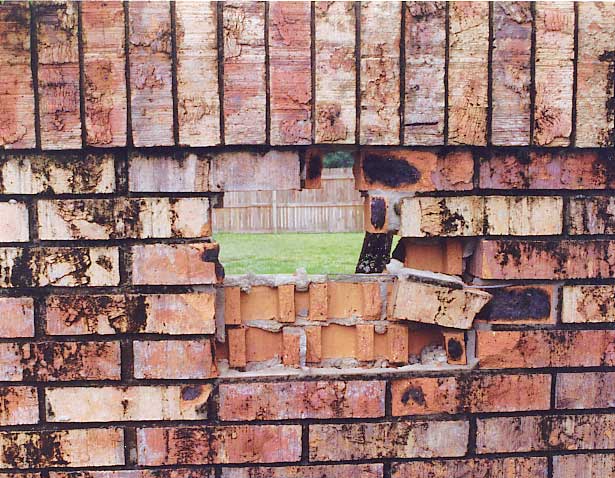
Where does lightning tend to strike? The answer is anywhere it wants and not always where you might expect. It follows the path of least resistance at a particular time, but that's always changing. When lightning begins to travel downward from a cloud, many objects that have built up a charge emit streamers. This could come from anything such as a blade of grass or a power pole. The first streamer to make contact with the bolt defines the final path the lightning will take. Who could know when and where that will be?
For instance, Here's a hole in a wall that blew out from a lightning strike not far from my house. The wall is normal brick and concrete and is about 6 feet tall. The incredibly high temperatures brought about by the lightning in the wall caused rapid expansion with such force it literally flew apart. It struck the side of the wall instead of the top and it didn't hit the 50-foot high power lines and towers just a few hundred feet away.
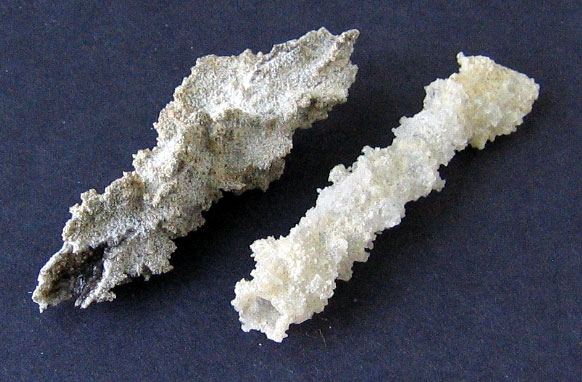
When lightning strikes the ground, another natural phenomena occurs. Central Florida is almost all sand. I can dig down as far as I can in my back yard, or front yard, and all I can find is nice clean white sand. When lightning strikes this, the sand is heated to the point where the it melts and fuses along the path or paths of the current. This forms a glass like artifact that is sometimes hollow and is called a Fulgurite. A sand fulgurite is fused silicon dioxide, SiO2. The Fulgurites in the picture are about 3 inches long. Fulgurites are very fragile, but if dug up carefully, can be found to be arranged like the roots of a tree and be many yards long. Fulgurites can be found almost anywhere in the world where lightning strikes the ground, whether it is sand, dirt or rock. The trick is in finding them, recognizing what they are, and excavating them without too much breakage. These samples weigh about 5 grams each.
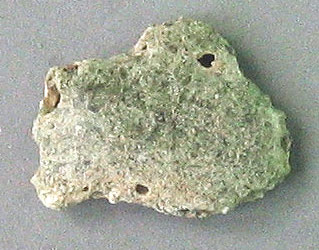 For more spectacular melting and fusion of
sand, a bigger blast was from the first atomic bomb detonation on July 16, 1945
in Trinity, New Mexico. The intense heat formed a grayish-green, glass like
material from the fireball and fused the desert sand into a jade green crater
2400 feet in diameter. Nearly 2000 tons of intensely radioactive material was
formed. It was mostly silica with traces of olivine and feldspar.
For more spectacular melting and fusion of
sand, a bigger blast was from the first atomic bomb detonation on July 16, 1945
in Trinity, New Mexico. The intense heat formed a grayish-green, glass like
material from the fireball and fused the desert sand into a jade green crater
2400 feet in diameter. Nearly 2000 tons of intensely radioactive material was
formed. It was mostly silica with traces of olivine and feldspar.
As soon as soil radiation dropped to safe levels, Trinitite pieces began to disappear into the hands of collectors and visitors looking for mementos. In 1975, Trinity was declared a national historic site and removing Trinitite was strictly prohibited. This sample of Trinitite is still radioactive but is only in the range of 0.3 to 0.5 mR/hr and is harmless. It is 7/8” wide and weighs 3.3 grams.
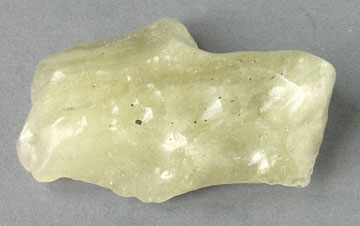 The mother of all glass-sand fusion is
found only near the Libyan-Egyptian border. The origin of the glass is a controversial
issue for the scientific community, with many evolving theories. Meteoric origins
for the glass were long suspected, but recent research linked the glass to
impact mechanics, such as vaporized quartz and meteoric metals, and to an
impact crater. Some geologists associate the glass not with impact melt ejecta,
but with radiative
melting from meteoric large aerial bursts. If that were the case,
the glass would be analogous to Trinitite, which is created from sand exposed
to the thermal radiation of a fireball.
The mother of all glass-sand fusion is
found only near the Libyan-Egyptian border. The origin of the glass is a controversial
issue for the scientific community, with many evolving theories. Meteoric origins
for the glass were long suspected, but recent research linked the glass to
impact mechanics, such as vaporized quartz and meteoric metals, and to an
impact crater. Some geologists associate the glass not with impact melt ejecta,
but with radiative
melting from meteoric large aerial bursts. If that were the case,
the glass would be analogous to Trinitite, which is created from sand exposed
to the thermal radiation of a fireball.
This action occurred in the North African desert about 28.5 Million years ago. To support the impact theory, the intense heat and pressure splashed melted sand up in the air and spread it over a large area of 4000 square kilometers. It created unusual shapes and small pieces of the original meteorite have been found imprisoned in the glass. A possible hint of iridium is an indicator for the extraterrestrial origin.
The glass is translucent yellow. The translucence may be caused by a white silica mineral found in volcanic rock and created at very high temperatures. One side shows thumbprint-like impressions similar to portions of the surface of a meteor that are vaporized as it passes through the earth's atmosphere. These in turn could be formed by vortices of hot gas. However, the underside is rough having not been exposed to wear, indicating it may have been molten when it landed on the ground some distance from impact at ground zero. Then, the thumb impressions could have been caused by wind erosion over a very long period of time.
About 10,000 years ago, men discovered this glass. It was used as a substitute for flint. Artifacts can be found that have been shaped as sharp blades and graters. The Egyptians considered the glass to be precious and so it became part of religious objects like Tutankhamen’s amulet where there is a carved scarab made of this glass. Libyan/Egyptian desert glass is now extremely difficult to obtain. Removing material from the site is prohibited by the Egyptian government. This sample is 3-1/4” wide and weighs 121 grams.
An article was published in the Orlando Sentinel on Sunday, June 23, 1996 titled "Leaky plumbing Linked to Lighting Strikes." Oddly enough, findings from the Orlando Utilities Commission in 1991 link pin hole leaks in copper water pipes to lightning strikes. This occurs much more frequently in plumbing that has a plastic line connecting the water meter to a home. PVC was used for this purpose starting in the early 1970's. Homes that have all metal piping appear less vulnerable. The theory is this: Lightning strikes the ground near a structure. An electrical charge travels through the ground until it hits a better conductor such as a home's buried metal plumbing or ground rod. The charge follows this until it hits a dead end like a plastic service line or other nonmetallic fitting that is a poor conductor of electricity. The charge then seeks other paths including water in the rest of the plumbing. It does this explosively like a "mini-lightning" strike and blows a tiny hole or holes in the copper pipe. Leaks can occur right away or may take up to a few months before making an appearance.

Here is a sample of copper water pipe that shows the effects of deterioration after a lightning strike. The pipe was buried in the ground and is less than 5-years old. The sand covering the pipe appears to be fused to it similar to the beginning of a fulgurite. One of the small holes can clearly be seen in the picture outlined by the copper color of the pipe. The green color is an indication of the reaction of copper and chlorine in the water.
Although our house has all copper plumbing, after a lightning strike hit a tree in the front yard, a pin hole leak appeared in a copper water pipe in the wall that went to the water heater. It went unnoticed for a while until the day I was chasing a skink (small lizard) and it led me to the damp wall behind the heater. It had apparently found a nice source of water and was living under the heater.
In 1991, the OUC built an experimental house to study the effects of chemical and other kinds of copper corrosion. Extremely high levels of copper were found in the water after intense thunderstorms. Rings of glassy red crystals were found around the punctures in the copper pipe. OUC chief chemist Dick Dunham was able to duplicate these crystals by heating copper and sand to a very high temperature in the lab. This provided further proof that it was lightning and not corrosion that caused the pin holes.
Not only is there the threat of lightning, but sometimes there can be a tornado. This can sometimes be seen as a water spout if it's over water.
Lightning and Trees
 Live trees are often struck by lightning
but don’t always die. The lightning is conducted through a branch or branches
to the trunk and can cause the bark at the side as well as the roots near the
ground to explode . The oak tree at the left is in Longwood, Florida. That
places it within the boundaries of lightning alley and it was hit 7 or 8 years
ago. The strike left a diagonal gash 2 to 3 inches wide and several feet long
exposing the white inner wood. It also blew some bark from exposed roots.
Live trees are often struck by lightning
but don’t always die. The lightning is conducted through a branch or branches
to the trunk and can cause the bark at the side as well as the roots near the
ground to explode . The oak tree at the left is in Longwood, Florida. That
places it within the boundaries of lightning alley and it was hit 7 or 8 years
ago. The strike left a diagonal gash 2 to 3 inches wide and several feet long
exposing the white inner wood. It also blew some bark from exposed roots.
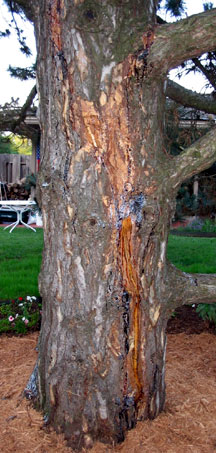 Over the years, the tree grew new bark and
now the open wound is completely healed but a visible scar remains. The tree
continues to grow nicely and no other visible evidence can be found to indicate
it was struck by lightning. In all that time, although the tree sands
relatively alone out in an open area, it has not been struck again.
Over the years, the tree grew new bark and
now the open wound is completely healed but a visible scar remains. The tree
continues to grow nicely and no other visible evidence can be found to indicate
it was struck by lightning. In all that time, although the tree sands
relatively alone out in an open area, it has not been struck again.
When lightning strikes a tree that is near a house, it may follow a path into the house through buried wires, plumbing or even roots and cause damage inside the house as well.
At the right is a large pine tree in Chanute, Kansas that was struck several weeks earlier. When lightning hits sap, it creates superheated steam that will blow the bark out There was damage from top to bottom on this tree and now there is lots of sap running from the exposed areas..
Damage to the pine tree could be seen near the top as well and is shown below. Because the damage was so severe and because the pitch was running and dripping all over, it was later taken down.
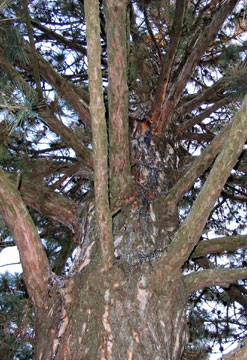 Trees that are struck don’t often catch on
fire either. However, trees that are dead or have dry dead wood are more likely
to catch fire than healthy trees that have been frequently pruned. In some
cases, no evidence of a lightning strike can be easily seen.
Trees that are struck don’t often catch on
fire either. However, trees that are dead or have dry dead wood are more likely
to catch fire than healthy trees that have been frequently pruned. In some
cases, no evidence of a lightning strike can be easily seen.
Such a situation occurred where a large oak tree was struck but the roots were right next to a plastic irrigation pipe and the lightning followed the pipe to the control wires and back to the irrigation timer box. The timer box and adjacent telephone box exploded and parts were blown from the side of the house into a neighbor’s yard.
No visible damage could be seen in the tree until the roots were exposed underground next to the irrigation pipe. The exit point could then be seen. In addition, the irrigation pipe had also exploded in several places and had to be replaced.
Lightning strikes cause rapidly expanding and contracting electromagnetic fields similar to EMP (elecrto-magnetic pulses), which induce electrical currents in nearby wires and electrical equipment. While vacuum tube equipment is relatively unaffected by such induced currents, solid state electronic devices can be easily damaged. In fact, a semiconductor microprocessor used in computers and other electronic devices can be damaged by a nearby lightning strike even if it is not in use or plugged into a wall outlet or phone line. A similar pulse occurs during an atomic explosion.
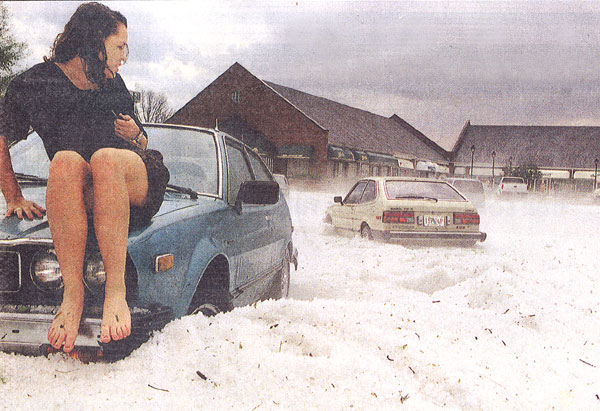
Another natural occurrence from the storms is hail. Although it doesn't always occur with a storm, it can be very damaging. Raindrops or snow pellets formed in cumulonimbus clouds are swept up in the air currents to where the air is below freezing. The hailstone grows when it contacts water that is not yet frozen and travels up and down many times. When the hailstone becomes too heavy for the air currents to support, it falls to the ground. Hailstones can range from 1/16" to as much as 6" in diameter.
Here is what happened at the Longwood Village Shopping Center just north of Orlando, FL. There was so much hail you couldn't even drive through it. Hail ranged from marble to golf ball size and anywhere from 4" to 12" deep. For many years afterwards, cars that were in this storm could be seen with small hail dents in the roof, hoods and trunks. Many house roofs and business advertising signs were also damaged. The storm was only about 3 miles wide. Photo is courtesy of Frank Rivera, The Orlando Sentinel, Saturday, March 7, 1992.
Here is an account set down by my father and the experience he and his family had with ball lightning. A summer storm was in the area of their New Hampshire farm in the summer of 1915. The farm was located in a hillside at an elevation of about 550 feet.
|
|
During a storm, A high DC voltage charge develops between the bottom of the storm cloud and the ground. When the voltage gets high enough, a massive breakdown of the air dielectric occurs, resulting in a lightning strike.
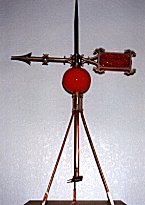 Benjamin Franklin and other scientists
believed lightning was electricity. In 1752 he proved it with his kite
experiment. His 21 year old son William was the only witness. He thought that
lightning would be preventable by using an elevated rod connected to the earth
to empty static from a cloud. What he invented and put to use was the lightning
rod. Since then, lightning rods have been the solution to protecting life,
property and avoiding a possible fire to dwellings, trees and other tall
structures. There are hundreds of patents that go back as far as 150 years.
Benjamin Franklin and other scientists
believed lightning was electricity. In 1752 he proved it with his kite
experiment. His 21 year old son William was the only witness. He thought that
lightning would be preventable by using an elevated rod connected to the earth
to empty static from a cloud. What he invented and put to use was the lightning
rod. Since then, lightning rods have been the solution to protecting life,
property and avoiding a possible fire to dwellings, trees and other tall
structures. There are hundreds of patents that go back as far as 150 years.
Typically, the rods are mounted on the roof of a barn or house. A basic lightning rod is made of solid copper about a foot long and 3/8" in diameter. It's pointed at one end and threaded at the other. It screws into a base that is mounted on a roof, chimney, etc. The base has a clamp and large bolt that can be tightened to connect with a heavy wire that carries the lightning charge to a ground rod sunk deep in the earth.
Some of the older rods and even some of the new ones serve several purposes. They can have a decorative colored glass or metal ball. The rod passes through the center of the ball. In addition, some also included a weather vane. The bottom of the rod is then connected to the heavy ground wire that runs to ground. Collecting lightning rod balls is a very active hobby.
The rods usually have a sharp point, although some argue that blunt points are best. The electric intensity, or potential gradient is greatest near a sharp point. Corona discharge will develop much sooner than with a blunt point. An adequate bleeder discharge from ground to cloud, although only a few milliamperes, can slow the voltage rise and reduce the chance of a strike.
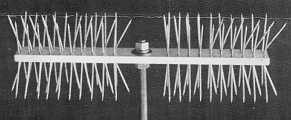 However, a single point has almost no
effect. Radio transmitter towers are often hit by lightning. An example of an
industrial strength discharge device is the "Staticat" made by the
Cortana Corporation in Farmington, NM. Here, many sharp points ionize the air.
This provides an even more effective path between the tower and the cloud.
Instead of the massive flow of current from a lightning strike, the small
continuous current discharges and protects the antenna system. The pointed
1/8" rods are made of 304 stainless steel that will resist corrosion. This
assembly measures only 18" by 2" and contains 120 points. Several of
these can be used on a tower.
However, a single point has almost no
effect. Radio transmitter towers are often hit by lightning. An example of an
industrial strength discharge device is the "Staticat" made by the
Cortana Corporation in Farmington, NM. Here, many sharp points ionize the air.
This provides an even more effective path between the tower and the cloud.
Instead of the massive flow of current from a lightning strike, the small
continuous current discharges and protects the antenna system. The pointed
1/8" rods are made of 304 stainless steel that will resist corrosion. This
assembly measures only 18" by 2" and contains 120 points. Several of
these can be used on a tower.
Although these devices are claimed to be as much as 95% effective, there is no guarantee that any discharge device will always prevent a lighting strike. A user on the Gulf Coast reported seeing 20 strikes to the radio tower equipped with discharge devices. Although there was some damage, they could see the glow of the discharge, indicating that the devices were working. Their past experience without the discharge devices was of much greater damage. Other opinions about static discharge devices is that they are totally useless. Unfortunately, the conditions in actual service are not exactly repeatable for a controlled experiment.
Another threat caused by these storms is the fires started by lightning. When the area is particularly dry and there's lots of dead brush, as in the 1998 Florida fires, There's a threat to everyone and everything. The lightning has also been observed to be more intense when the air is filled with smoke right up to the cloud layer, such as from the Mexican fires during the same year.
When air is heated by lightning, it expands outward rapidly and generates loud sound waves that is thunder. The lightning usually has an irregular shape and strikes at an angle. The sound does not all arrive at the same time. Light travels in air at close to 186,000 miles per second and lightning can be seen instantly. Sound travels at about 1/5th of a mile per second and arrives some time later depending on how far you are from the lightning. Knowing this, you can estimate how far away the bolt was by counting the seconds and dividing by 5. This will give you the number of miles or fraction of a mile. When a near hit occurs, the two seem instantaneous. The voltage involved in initiating a cloud-to-ground strike ranges from 100 million to 1 billion Volts. The average peak current in a cloud-to-ground lightning strike is 100,000 Amperes.
The temperature of a lightning leader is about 50,000° F (27,600° C). The average temperature of the sun's surface: 11,000° F (6000° C). The average duration of peak current in a lightning discharge is 1/1000 sec. The estimated diameter of a lightning leader is 0.5 to 1 inches (1.3 to 2.5 cm). The length of a cloud-to-ground lightning channel is between 2 and 10 miles and averages about 6 miles. An estimated 500-1000 people are struck by lightning every year in the U.S.
There are 6000 lightning strikes occurring somewhere in the world every minute. An average thunderstorm is 6 to 10 miles wide. Thunderstorms travel at an average speed of 25 mph. On average, thunder can be heard over a distance of only three to four miles. This distance can vary depending on humidity, terrain, and other factors. With overhanging anvil clouds, the danger of deadly lightning is imminent when the storm's leading edge is within 10 miles.
Observations now show that red areas called sprites often occur after and above a regular lightning strike. They can spread up to 60 miles into the atmosphere and can occupy as much as 2500 cubic miles in volume. Smaller displays call jets are also observed. Very little is known about these phenomena.
Lightning creates nitrates that are essential to plant growth. It also creates ozone, which may be related to the existence of the ozone layer in our atmosphere.
Florida has about one million cloud-to-ground lightning strikes each year. The number one area for fatalities is in open fields, followed by water related areas, under trees, and driving equipment like farm tractors. These occurred mostly in the months of June and July in the afternoon averaging at about 3:49 PM.. Being struck by lightning does not mean it is always fatal. There are many survivors of lightning strikes.
 Detectors are now used at sporting events,
golf courses, etc. as well as industries that have employees or clients exposed
to the threat of lightning. Although an ordinary AM radio can be used to
indicate the presence of lightning by producing static, indicators specifically
designed for lightning detection are more useful. Indicator lights and beepers
can warn people out in the open of imminent storms. The detector can flash more
rapidly or beep louder as the storm nears. Some can indicate lightning strikes
as much as 300 miles away, although false triggering can be a problem.
Sensitivity is usually adjustable. The detector is often directional and can be
rotated to locate the strongest direction.
Detectors are now used at sporting events,
golf courses, etc. as well as industries that have employees or clients exposed
to the threat of lightning. Although an ordinary AM radio can be used to
indicate the presence of lightning by producing static, indicators specifically
designed for lightning detection are more useful. Indicator lights and beepers
can warn people out in the open of imminent storms. The detector can flash more
rapidly or beep louder as the storm nears. Some can indicate lightning strikes
as much as 300 miles away, although false triggering can be a problem.
Sensitivity is usually adjustable. The detector is often directional and can be
rotated to locate the strongest direction.
Detectors range from simple circuitry to more sophisticated detectors like the Skyscan shown at the left. These features include reduced false triggering. Accuracy is claimed to be within 1-2 miles 97% of the time.
Another warning device is a radio with a weather alert feature. The alert can often be set as either a blinking light or an alarm. These radios receive the NOAA weather station for current local conditions. The alert applies to all kinds of weather including hurricanes, tornadoes, and some violent thunderstorms. However, it does NOT activate the alarm for ALL thunderstorms.
Florida's natural resource of lightning makes it an ideal place for study. At Camp Blanding, about 50 miles north of Tampa, lightning studies are very active. Here, lightning is triggered by launching a three foot solid fuel rocket into a thundercloud. A wire carried by the rocket is unwound as it travels to the cloud. If the electric potential is great enough, it will trigger a strike and follow the wire to the test target. The test area was constructed and funded by a joint effort between Florida Power Corporation and the Electric Power research Institute and it is operated by the University of Florida. This association called the ICLRT was formed in October of 1994. The center occupies about 100 acres. Initially, research was devoted to the effects on overhead power lines. However, lightning also affects underground power lines that many new customers are using and efforts are being directed in this area also.
Lightning is not just confined to air disturbances in cumulonimbus clouds. It also occurs in large hurricanes, tornadoes and even snow storms. Non-weather sources can also produce lightning such as volcanoes, forest fires and surface nuclear detonations. A common theme for all of these sources seems to be places where temperature differences, water droplets or dust particles and friction are involved.

Here is a recent picture from a volcano eruption in Iceland. Although I have never personally witnessed a volcanic eruption like this, it must have been a terrifying experience to witness the gigantic billowing cloud of ash but then to have the added frequent lightning and loud thunder to go along with it must have been even more dramatic. I can imagine why those who did not understand what was happening attributed to this to anger of the gods or some such thing. When hot lava and ice come in contact, the result is a tremendous explosion of fine dust particles. Volcanic ash is electrically conductive, particularly when wet.
The primary rule is not to get in the way of natural occurrences no matter what they are.
|
|
||
|
|
Lightning Strike & Electric Shock Survivors International, Inc. |
|
|
|
||
|
About This Site |
||
|
|
More text and pictures will be added as my research continues. Any contributions, comments, corrections, or additions are welcome. |
|
|
Email
to |
|
Created by Roger Russell |
